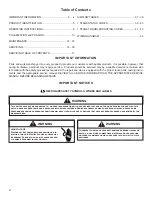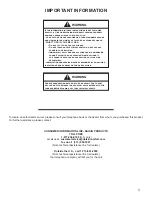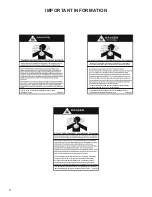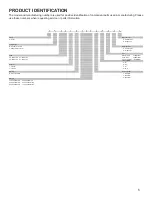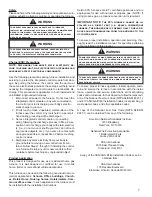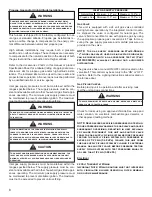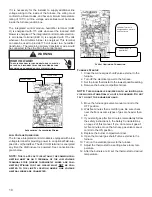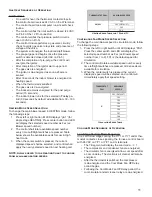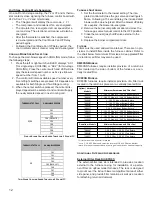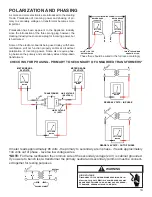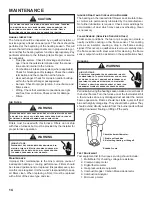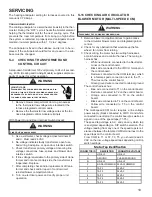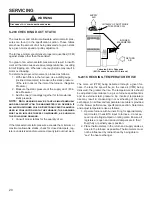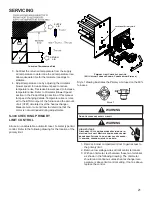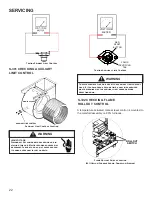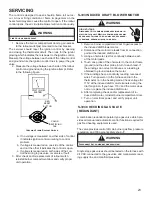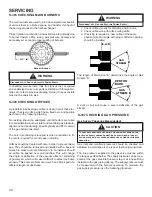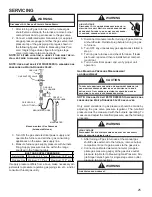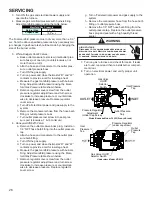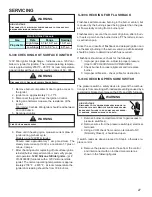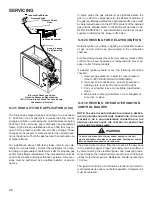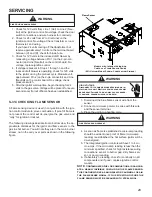
MAINTENANCE
14
14
CAUTION
If you must handle the ignitor, handle with care. Touching
the ignitor body with bare fingers, rough handling, or
vibration could result in early ignitor failure. Only a
qualified servicer should ever handle the ignitor.
Annual Inspection
The furnace should be inspected by a qualified installer, or
service agency at least once per year. This check should be
performed at the beginning of the heating season. This will
ensure that all furnace components are in proper working or
-
der and that the heating system functions appropriately. Pay
particular attention to the following items. Repair or service
as necessary.
•
Flue pipe system. Check for blockage and/or leak
-
age. Check the outside termination and the connec-
tions at and internal to the furnace.
• Combustion air intake pipe system (where applicable).
Check for blockage and/or leakage. Check the outside
termination and the connection at the furnace.
•
Heat exchanger. Check for corrosion and/or buildup
within the heat exchanger passageways.
•
Burners. Check for proper ignition, burner flame, and
flame sense.
• Wiring. Check that electrical connections are tight
and free from corrosion. Check wires for damage.
• Filters.
Air Filter
WARNING
Never operate the furnace without a filter installed as dust
and lint will build up on internal parts resulting in loss of
efficiency, equipment damage, and possible fire.
Filters must be used with this furnace. Filters do not ship
with these furnaces but must be provided by the installer for
proper furnace operation.
WARNING
HIGH VOLTAGE
Disconnect ALL power before servicing or in
-
stalling this unit. Multiple power sources may
be present. Failure to do so may cause proper
-
ty damage, personal injury or death.
Maintenance
Improper filter maintenance is the most common cause of
inadequate heating or cooling performance. Filters should
be cleaned (permanent) or replaced (disposable) every two
months or as required. It is the owner’s responsibility to keep
air filters clean. When replacing a filter, it must be replaced
with a filter of the same type and size.
Induced Draft and Circulation Blowers
The bearings in the induced draft blower and circulator blow
-
er motors are permanently lubricated by the manufacturer.
No further lubrication is required. Check motor windings for
accumulation of dust which may cause overheating. Clean
as necessary.
Flame Sensor (Qualified Servicer Only)
Under some conditions, the fuel or air supply can create a
nearly invisible coating on the flame sensor. This coating
acts as an insulator, causing a drop in the flame sensing
signal. If this occurs, a qualified servicer must carefully clean
the flame sensor with steel wool. After cleaning, the flame
sensor output should be as listed on the specification sheet.
Burners
WARNING
HIGH VOLTAGE
Electrical components are contained in both
compartments. To avoid electrical shock, inju
-
ry or death, do not remove any internal com
-
partment covers or attempt any adjustment.
Contact a qualified service agent at once if an
abnormal flame appearance should develop.
Periodically during the heating season make a visual check of
the burner flames. Turn the furnace on at the thermostat. Wait
a few minutes since any dislodged dust will alter the normal
flame appearance. Flames should be stable, quiet, soft and
blue with slightly orange tips. They should not be yellow. They
should extend directly outward from the burner ports without
curling downward, floating or lifting off the ports.
Check the burner flames for:
1. Stable, soft and blue
2. Not curling, floating, or lifting off.
Burner Flame
Test Equipment
Test equipment list for furnace servicing should include:
1.
Multi-Meter for checking voltage & resistance
2. Clamp-on amp meter
3. Digital thermometer
4. Gas pressure test equipment
5.
Combustible gas / Carbon Monoxide detector
6. Combustion Analyzer
7. Micro-amp meter


